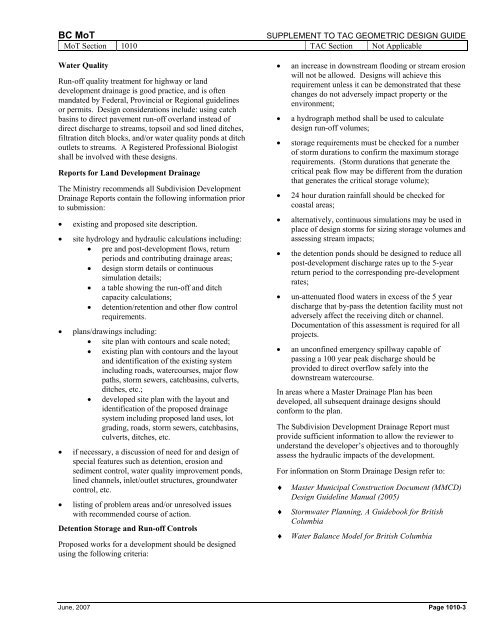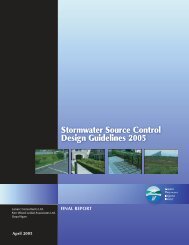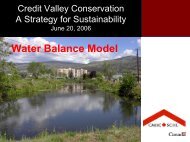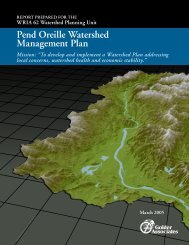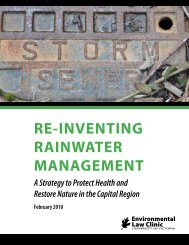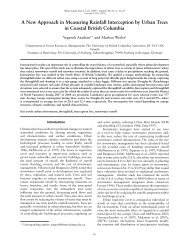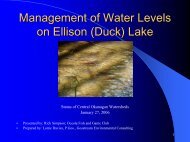1000 Hydraulics Chapter - Ministry of Transportation
1000 Hydraulics Chapter - Ministry of Transportation
1000 Hydraulics Chapter - Ministry of Transportation
You also want an ePaper? Increase the reach of your titles
YUMPU automatically turns print PDFs into web optimized ePapers that Google loves.
BC MoT<br />
SUPPLEMENT TO TAC GEOMETRIC DESIGN GUIDE<br />
MoT Section 1010 TAC Section Not Applicable<br />
Water Quality<br />
Run-<strong>of</strong>f quality treatment for highway or land<br />
development drainage is good practice, and is <strong>of</strong>ten<br />
mandated by Federal, Provincial or Regional guidelines<br />
or permits. Design considerations include: using catch<br />
basins to direct pavement run-<strong>of</strong>f overland instead <strong>of</strong><br />
direct discharge to streams, topsoil and sod lined ditches,<br />
filtration ditch blocks, and/or water quality ponds at ditch<br />
outlets to streams. A Registered Pr<strong>of</strong>essional Biologist<br />
shall be involved with these designs.<br />
Reports for Land Development Drainage<br />
The <strong>Ministry</strong> recommends all Subdivision Development<br />
Drainage Reports contain the following information prior<br />
to submission:<br />
• existing and proposed site description.<br />
• site hydrology and hydraulic calculations including:<br />
• pre and post-development flows, return<br />
periods and contributing drainage areas;<br />
• design storm details or continuous<br />
simulation details;<br />
• a table showing the run-<strong>of</strong>f and ditch<br />
capacity calculations;<br />
• detention/retention and other flow control<br />
requirements.<br />
• plans/drawings including:<br />
• site plan with contours and scale noted;<br />
• existing plan with contours and the layout<br />
and identification <strong>of</strong> the existing system<br />
including roads, watercourses, major flow<br />
paths, storm sewers, catchbasins, culverts,<br />
ditches, etc.;<br />
• developed site plan with the layout and<br />
identification <strong>of</strong> the proposed drainage<br />
system including proposed land uses, lot<br />
grading, roads, storm sewers, catchbasins,<br />
culverts, ditches, etc.<br />
• if necessary, a discussion <strong>of</strong> need for and design <strong>of</strong><br />
special features such as detention, erosion and<br />
sediment control, water quality improvement ponds,<br />
lined channels, inlet/outlet structures, groundwater<br />
control, etc.<br />
• listing <strong>of</strong> problem areas and/or unresolved issues<br />
with recommended course <strong>of</strong> action.<br />
Detention Storage and Run-<strong>of</strong>f Controls<br />
Proposed works for a development should be designed<br />
using the following criteria:<br />
• an increase in downstream flooding or stream erosion<br />
will not be allowed. Designs will achieve this<br />
requirement unless it can be demonstrated that these<br />
changes do not adversely impact property or the<br />
environment;<br />
• a hydrograph method shall be used to calculate<br />
design run-<strong>of</strong>f volumes;<br />
• storage requirements must be checked for a number<br />
<strong>of</strong> storm durations to confirm the maximum storage<br />
requirements. (Storm durations that generate the<br />
critical peak flow may be different from the duration<br />
that generates the critical storage volume);<br />
• 24 hour duration rainfall should be checked for<br />
coastal areas;<br />
• alternatively, continuous simulations may be used in<br />
place <strong>of</strong> design storms for sizing storage volumes and<br />
assessing stream impacts;<br />
• the detention ponds should be designed to reduce all<br />
post-development discharge rates up to the 5-year<br />
return period to the corresponding pre-development<br />
rates;<br />
• un-attenuated flood waters in excess <strong>of</strong> the 5 year<br />
discharge that by-pass the detention facility must not<br />
adversely affect the receiving ditch or channel.<br />
Documentation <strong>of</strong> this assessment is required for all<br />
projects.<br />
• an unconfined emergency spillway capable <strong>of</strong><br />
passing a 100 year peak discharge should be<br />
provided to direct overflow safely into the<br />
downstream watercourse.<br />
In areas where a Master Drainage Plan has been<br />
developed, all subsequent drainage designs should<br />
conform to the plan.<br />
The Subdivision Development Drainage Report must<br />
provide sufficient information to allow the reviewer to<br />
understand the developer’s objectives and to thoroughly<br />
assess the hydraulic impacts <strong>of</strong> the development.<br />
For information on Storm Drainage Design refer to:<br />
♦<br />
♦<br />
♦<br />
Master Municipal Construction Document (MMCD)<br />
Design Guideline Manual (2005)<br />
Stormwater Planning, A Guidebook for British<br />
Columbia<br />
Water Balance Model for British Columbia<br />
June, 2007 Page 1010-3


